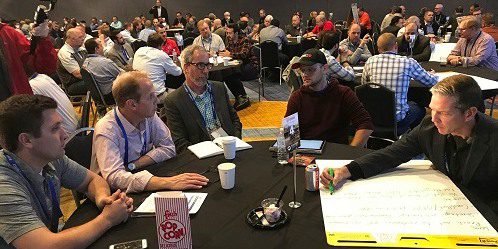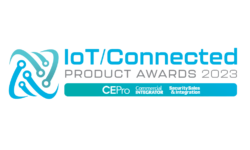32 Tips for Low-Voltage Contractors to Turbocharge Their Business
Low-voltage pros shared what they charge for design fees, how they generate RMR and other business-building best practices during a Total Tech Summit 2019 session.
What comes to mind when you hear the word summit? Meeting of the minds? Peak of a mountain? Maybe it’s both; a meeting of the minds that can help each other climb toward that mountain top. That’s what the Total Tech Summit assists with every year when top low-voltage integrators freely share ideas, profit tips, and best practices during roundtable discussions.
At this year’s Total Tech Summit in Fort Worth, Texas, the three-day event kicked off with valuable roundtable time that brought residential, commercial and security technology specialists together.
The overriding theme was improving business processes and profit tips… which, of course, leads to success branching out to new services, better brand recognition within your community and more. Sponsored by D-Tools, the three chief subtopics of discussion further dug down into areas of sales and marketing improvement ideas; operational improvement; and client care and revenue optimization.
Randy Stearns, CEO of D-Tools and a longtime integrator himself, kicked off the brainstorming with two of his own business process improvements and profit tips that had tremendous bottom-line results.
1: GET A DESIGN SERVICES AGREEMENT
First, he advised integrators to all consider signing a design services agreement and collecting a design retainer fee from every client. At his company, prior to charging for design services the company averaged a less than 50% closing rate.
“We were unable to get our proposals out. It was taking two to three weeks to get out a basic proposal and six weeks for larger projects,” he recalls. “When you are slow on the turnaround for proposals, the client thinks you will be slow on the delivery side. It was a problem and we had to solve it.”
So, Stearns started charging for design services. First, it meant the company was doing fewer proposals because it was weeding out the tire-kickers. That meant the sales and engineering teams could turn around proposals in days versus weeks.
“It eliminated the competition. Once someone signs something and gives you money, they are not shopping you anymore. They’ve made a decision,” he says. “Our close ratio went to 90%. It turned our design department into a profit center and we increased overall sales by 20%.”
2: BOOST LABOR UTILIZATION TO 87%
Stearns also shared how he was able to boost his labor utilization rate from 65% to 87%.
“The guys would come into the office, chit-chat a little bit, load up their van, have some coffee. And then they sit in traffic. You are paying them for all that time. They work 5.5 to 6 hours on the jobsite, then drive home in traffic again and go home. It’s not a good model… it’s not a profitable model,” comments Stearns.
The solution was rather simple. Stearns had his technicians take their vans home with them, then drive straight to the jobsite and clock in as soon as they arrived and clock out when they left the jobsite.
“Our labor utilization jumped to 87%. The only time that wasn’t billable was PTO, holidays and our bi-weekly safety/tech meetings,” he says. “It had the same effect as if we had added another team of technicians. It was a win-win-win.”
Here’s a look at 30 other suggestions shared with the entire room at the Summit after participants swapped stories for 20-minute discussions per big topic.
Sales & Marketing Improvement Tips
3. Using CRM (Customer Relationship Management) software to track leads and revenues by source type is a beneficial way to generate and keep track of leads, and the effectiveness of each. Tying in a CRM system to business management software such as D-Tools takes it to an even more efficient level.
4. Avoiding bidwork (this suggestion received chuckles of approval) and guarantee profit for the company, instead of wasting a lot of time and effort.
5. Charging for design services; a common amount is 3% fee.
6. Find a niche and reach out to similar-minded trades. One integrator works with homeowners’ associations and after completing one development noticed HOAs are very competitive; the integrator went to all the other nearby HOAs and sold upgrade packages.
7. Giving American Express gift cards to referral partners or monitoring credits to a referral.
8. Using online reviews as part of SEO and SMO. Using social media more to spread word.
9. No proposals go out without being looked at by a sales engineer or some type of vetting process, to help avoid redundant or extra work.
Lead Generation Tips
10. Be more selective on the leads and thoroughly review all the bids before they go out.
11. For identifying leads and new business development opportunities, ensure exceptional customer service awaits.
12. Property managers on custom high-end homes can be responsible for a lot of the maintenance of those systems; they’re able to get helpful ideas and bring on new business because now that property manager or owner’s project manager or consultant will help to bring them new projects
13. At CEDIA Expo this past year one integrator sent two sales team members to become CEDIA outreach instructors. There’s not a lot of competition doing that, the integrator points out, so they were able to draw in specifiers who wished to further their education. They’re now sending a lot more clients the integrators’ way.
14. A couple of companies stage annual tech expos where they bring in vendors, manufacturers, and provide extra value by having breakout sessions or keynote speaker.
Operational Improvement Tips
15. Perform annual tech reviews with clients, and then asking for referrals at the end of those meetings; too often integrators are face-to-face with customers and forget to ask — and it can really generate a lot of extra business, Summit attendees said.
16. There’s a lot of time involved in technicians taking cardboard boxes into a van, out of a van, into a house, out of a house, into the dumpster, etc. Save money during the job prep by removing all that stuff from the cardboard – take your speakers out, take your grilles, put them all in a dedicated box. Put it on a tool cart, put all of the speakers you need on there so the tech knows exactly what he needs, he’s not installing the wrong product in the wrong room. Make another cart for the control panels, wall plates, trim devices and package it with a room identifier – the technician wheels it in, installs it … he’s done for the day.

Dealers say 3% of the total project cost is the targeted percentage to charge for design services. That was just one of the profit tips revealed during roundtables at Total Tech Summit 2019.
17. Talking about schedule changes and trying to keep technicians busy while schedule changes happen … one idea, reserving bandwidth for when a schedule shifts. Ensure a backlog of things to do built into your schedule so if you have to take care of an emergency you have that bandwidth in there but otherwise you have that backlog of items ready to go.
18. Partnering with an IT company that’s already working with a client; if you’re trying to remote into a system, instead of reinventing the wheel, work with that client’s IT partner onsite and you’ll get good results that way.
Employee Recruitment, Retention & Productivity Tips
19. Develop a pay scale and implement grading for lower levels of techs; one integrator has techs that are up and down the pay grade and they know internally “what their superpower is” but establishing a pay grade gives more clarity to what’s a level 1, a level 2, a commissioned person and so on.
20. Establish difficulty factors for various projects so you can assign certain types of jobs to certain PMs and certain teams that are better at one thing; maybe they’re better at handling a difficult client, maybe they’re better with new construction, with wood construction. One integrator has employees that have woodworking backgrounds and others that have metal working backgrounds; they get assigned to the projects that make the most sense for their skills.
21. Bring in sales and tech employees that were not from the industry. Sometimes hiring highly certified or specialist staff also carries 15 or 20 years of bad habits that are time-consuming to try and break, rather than just starting from scratch. Interview people that are mechanically inclined, that comes to work every day, have a good attitude and willingness to learn (from your employees that have good habits).
22. Keep in mind having PMs do scheduling themselves requires some heavy communication, not just weekly but almost daily
23. Tracking technicians, many using Verizon Connect or other project management tools for tracking productivity, how long they’re on a jobsite, billing, field office communications, etc.
24. Training employees, building a good culture and hiring people to fit that corporate environment.
Client Care & Revenue Optimization Tips
25. When it comes to selling service contracts, every proposal should have a good/better/best and/or some form of automatic inclusion in a proposal.
26. Bundling maintenance in your proposal with an autorenewal; consider the option of allowing payment for the first two years all at once.
27. Use software that communicates with clients if they’ve come online and have looked at a proposal maybe a year, two years ago – it will show what they didn’t opt for; also incentivize technicians to sell and upsell to clients while at a jobsite.
28. Making the service contract a requirement and talking to your salespeople about it, truly making them understand that it’s not an option for a client to say no. And then structuring those services in a way that would satisfy various needs, so you could tell customers this is a priority but they have options.
29. Technology that allows you to monitor different devices remotely, at the location, and the client or service department can have apps to allow you to reboot and charge for that; services priced different ways – some people price one fee no matter how many devices you have, others were charging per room that they have the devices in.
30. Actively branding your service department; give it a name and make sure your sales team knows the features the organization provides.
31. Make it easy for the customers and don’t put a price tag on service. Sounds crazy but works – take your price off it and change your model to an on-demand service. Tell clients, call when you need; here’s a negotiated price for that service.
32. Incentivizing the salesperson to sell service contracts … and let them share in the residuals. The alarm industry knows a little bit about residual, notes this security provider, who’s had success with this approach for nearly two dozen years. Technicians and salespeople that have been with the company for years don’t even think about leaving because their residual has grown to the point where they’re just not going to go make that money somewhere else. Share the wealth with your people.
Editor’s Note: This story first ran on Security Sales & Integration’s sister publication CE Pro.
If you enjoyed this article and want to receive more valuable industry content like this, click here to sign up for our FREE digital newsletters!

Security Is Our Business, Too
For professionals who recommend, buy and install all types of electronic security equipment, a free subscription to Commercial Integrator + Security Sales & Integration is like having a consultant on call. You’ll find an ideal balance of technology and business coverage, with installation tips and techniques for products and updates on how to add to your bottom line.
A FREE subscription to the top resource for security and integration industry will prove to be invaluable.








